Service Maps help organize IT services into a hierarchical structure and provide clear visibility to services and resources dependent on the services.
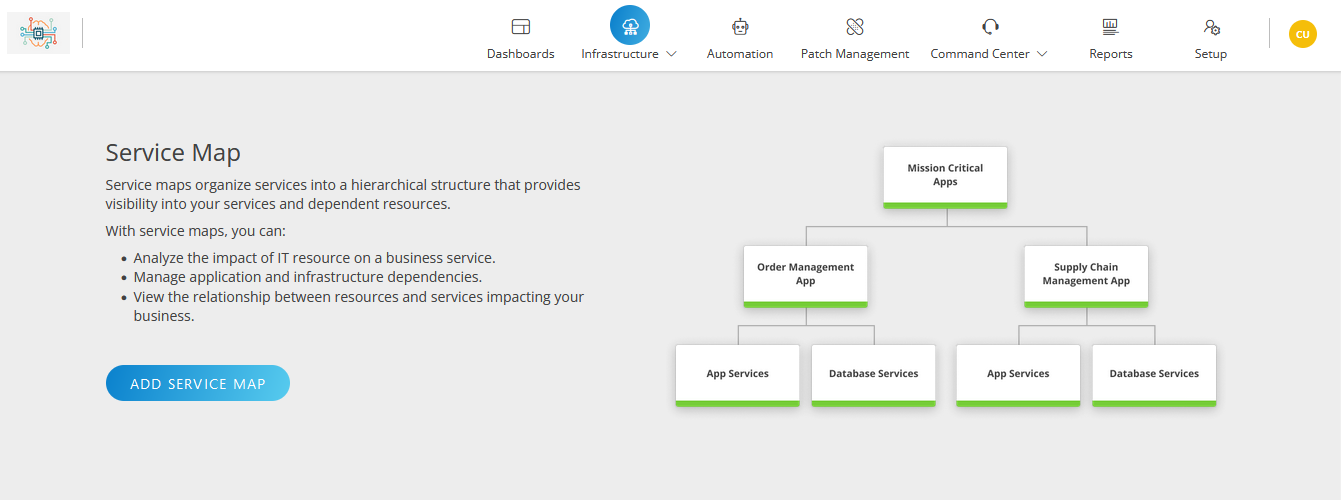
Create service maps
Rules need to be defined to interlink a parent node with its child nodes. Service Maps automatically tracks service impacts based on the defined rules.
Best practices for creating Service Maps include:
- Identify the dependencies of a service.
- Assess the topology for high availability or point of failures that determine the health of a service or a critical application.
Creating a Service Maps involves:
- Creating a Service Maps with a parent node.
- Adding a child node to the Service Maps
Step 1: Create Service Maps with a parent node
- From All Clients, select a client.
- Go to Infrastructure > Services Maps. The SERVICE MAPS landing page is displayed.

Click the + ADD button..
Enter a Service Maps name in the New Service Name box and click Save.
Mouse hover over the New Service Name box to view and click the Settings icon, define availability and assign articles to the node.
Name: Enter a parent node name.
Node Type: By default, the type is
SERVICE.Availability Threshold: Availability helps you to define the status of a node. Supported nodes statuses are: Up, Down or Degraded.
- % of down members: Define the availability on the basis of the percentage of services in a group. For example, if 50% of services in a group are down, the status of a service node is considered to be Down.
- # of down members: Define the availability on the basis of the number of services in a group. For example, if 10 services in a group are down, then the status of a service node is considered as Down.
Send an alert when this service is down: Select to get an alert notification.
Assign knowledge base articles to the node.
Click Save.
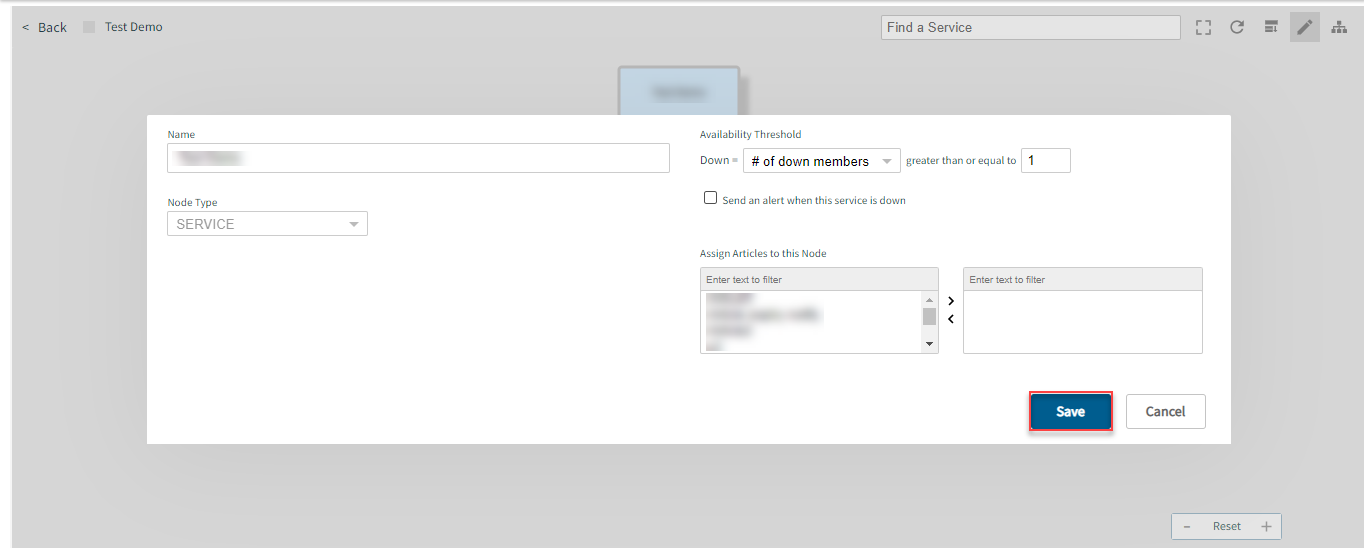
Step 2: Add child nodes
- Click the Add icon on the parent node.
- Add a child node using one of the following methods:
- Add resources or services to the node
- Import a node from another Service Maps
- Link a node that exists in another Service Maps
Add resources and services
Enter a name for the node and click Save.
Click the Settings icon to configure the node.
Select the required Node Type from the drop-down list. To add a Web service to a node, select Node Type > Others and select Resource > Web Service.
Add resources to the node. From the Resource Selection field, select one of the following options:
- Select Rule-based to add resources automatically using a policy. The service groups dynamically shrink or expand based on new or decommissioned resources.
- Select Manual to add resources manually.
If you select Rule-based, do the following steps:
- Choose from All or Any rules to apply as a filter for the resources/services.
- You can filter for resources using resource attribute name, a logical expression, and value to filter resources using the logical expression Regex. A list of matching resources is displayed in the Matching Members section.
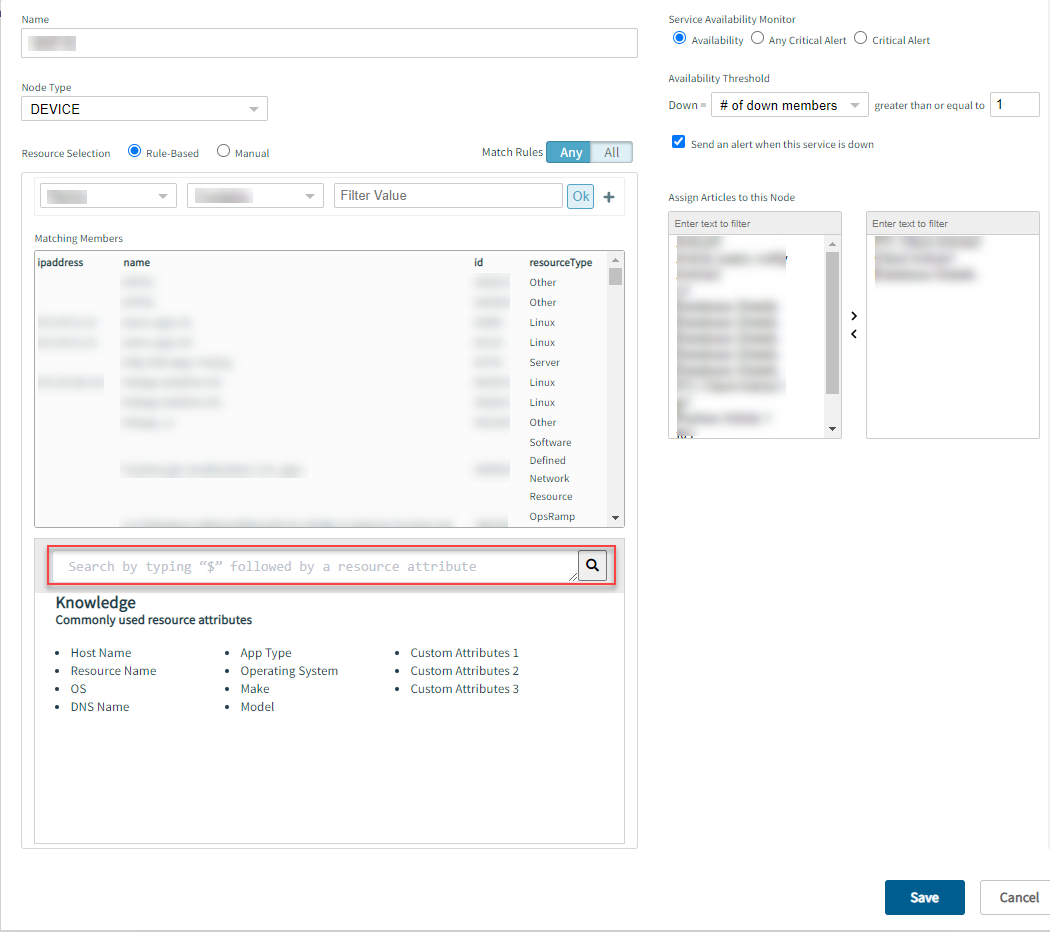
When Rule-based option is selected with Advance Search or Normal Rules, devices are automatically added to the service nodes when new devices are on boarded or existing devices have been updated that match the given rules.
- Add resources to the node, using query language specifying your requirements, using the Advanced query box.
To enter a query:
Type “$” followed by a resource attribute. Once you type “$” the resource attributes are auto-populated.
Examples of resource attributes: App Type, Operating System, DNS Name, etc. - Select the attribute followed by a space and key operator value.
Examples of key operator value: “<”, “>”, “=”, “IS”, “contains”, “IS NOT NULL”, “IN”, etc. - Give a space after you select/enter the key operator value and enter the Value enclosed in double quotes. You can give multiple queries. Use AND or OR condition between the queries, as needed.
- A green tick after entering a query indicates that the query is valid. A forbidden icon indicates that the query is incomplete or the format is incorrect.
- Click the search icon. The number of resources that match the query is displayed. Click Show Matching Results. The resource list is displayed with Name, IP Address, and Resource Type details.
Note: When usingREGEXandREGEX NOT:
Avoid using square brackets with
\dor\sFor example:
$name REGEX "a[\s+].*"
This expression can be written as$name REGEX "a\s+.*"$name REGEX "a[\d+].*"
This expression can be written as$name REGEX "a\d+.*"
Avoid using
^and$in attribute values.For example:
$name REGEX "^abc.*"
This expression can be written as$name REGEX "abc.*"$name REGEX ".*abc$"
This expression can be written as$name REGEX ".*abc"
If you select Manual, from the Manually Assign Resources section, select the resources from the left box and click > icon. The selected resources are added to the right box.
From Service Availability Monitor, select one of the following options to define the node status:
- Availability: If an availability alert triggers on a resource, the status of a node also is impacted.
- Any Critical Alert: If any critical alert is triggered by the service group, the status of a node also is impacted. Ensure to define availability rules on the resource/service. Any critical alert triggered on the resource/service raises an availability alert and impacts a node.
- Critical Alert: If a critical alert is triggered on the selected metrics, the status of a node also is impacted. All selected metrics on the individual resources need to be in a critical alert state for the service node to be marked as down, or unavailable. In the case there is a healed alert, the service node is displayed as available, or in green, because this option requires the alerts to be in a critical state.
Enter the values in Availability Threshold. The status of a node is defined by the Service Availability Monitor and Availability Threshold. In addition to the options in service availability monitor, if a certain number of resources are Down in the availability threshold, the node status is displayed as Down. Define an availability rule on the resource/service. Any critical alert triggered on the resource/service raises an availability alert and impacts a node.
Click Save.
The child node is added to the parent node and is displayed on the Service Maps page.

Click Back to navigate to the Service Maps listing page. All the services created are displayed on this page.
Import Service Maps as a node
An existing Service Maps can be imported as a node to the other Service Maps.
An imported Service Maps as a node is local to the Service Maps to which it is imported. A parent-level node or a child-level node can be imported.
As the imported Service Maps as a node acts as a local node in a Service Maps, any update made on the imported Service Map is applicable only to the current Service Maps and not to the other Service Maps using the same Service Maps.
To import a node:
Click the Import icon on the child node.
From Import Node and Sub-hierarchy, enter:
- From the Service Maps drop-down, select the required Service Maps to which the node belongs.
- From the Node drop-down, select the required node.
Click Save.
Link Service Maps
This option allows linking or sharing of an existing Service Maps with other Service Maps as nodes. Any change performed on the linked Service Maps reflects on the parent service as well. A user cannot edit a shared service in a parent Service Maps.
To link a node:
- On the child node, click the Link icon.
- Select the required Service Maps from the drop-down list.
- Click Save. The Service Maps is linked to the child node and a link icon is displayed on the node.
A user can only link or share a parent level node. If a parent node is shared, then the child nodes are also shared.
Unlink linked nodes
To unlink the linked node from the Service Maps:
- Open the Service Maps, click the Edit icon, mouse hover to the linked service node and click the Delete icon.
- On the confirmation message, click Unlink.
- Click OK.
Search
From the Service Maps page, in the Find a Service box, enter the required service name. The Service Maps node is displayed.
Node summary
The node summary provides entity information that is impacting a service group.
To view a node summary:
From the Service Maps page, click the required Service Maps.
Click the required node to view the summary and resource details.
The Summary of the node is displayed on the right pane displaying the following details:
- Articles: Knowledge base articles linked to the node.
- Custom Attributes: Custom attributes provide the ability to create attributes for resources separate from the attributes. You may add, view, edit, or remove the custom attributes by following the steps:
- Click the Service Maps, on the side panel select add custom attributes
- The Custom Attributes page appears.
- Select the Scope, from the drop down list, enter the Custom Attribute Name, and Custom Attribute Value.
Notes:- Selecting Client from Scope, displays all the client level custom attributes, Partner displays all the partner level custom attributes, and All, displays all the partner and client level custom attributes.
- Partner level users can delete Client level attributes but client level users cannot delete partner level attributes.
- Click the bin icon to remove the attribute.
- Click + Add Custom Attribute, to add more attributes category.
- Click Save.
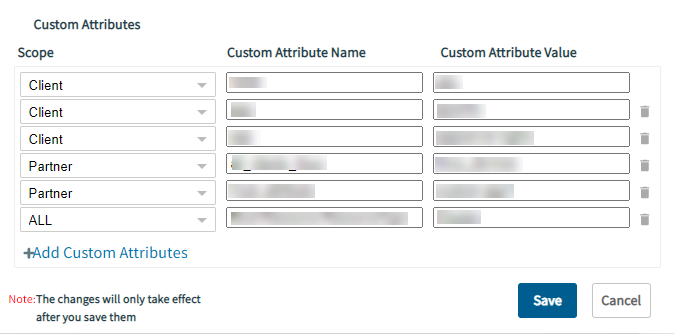
- Down Since: Date and time when the node is Down.
- Services: Number of nodes/services that are impacted due to the selected node.
- Alerts: Number of alerts triggered on the node.
- Tickets: Number of Incidents created on the node
- Service Impacting Resources: List of resources/services available in the node.
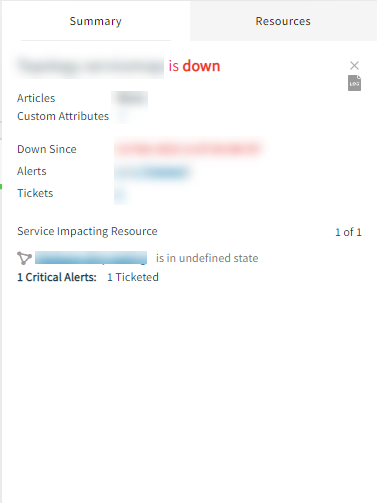
- The Resources tab includes the resources in the node including their status. A user can further filter for resources based on the resource state. For example, to view resources which are Up, select the status Up from the drop-down list.
Filters
The filter option filters Service Maps based on the following criterion:
- Service Maps Type
- Service Maps Availability
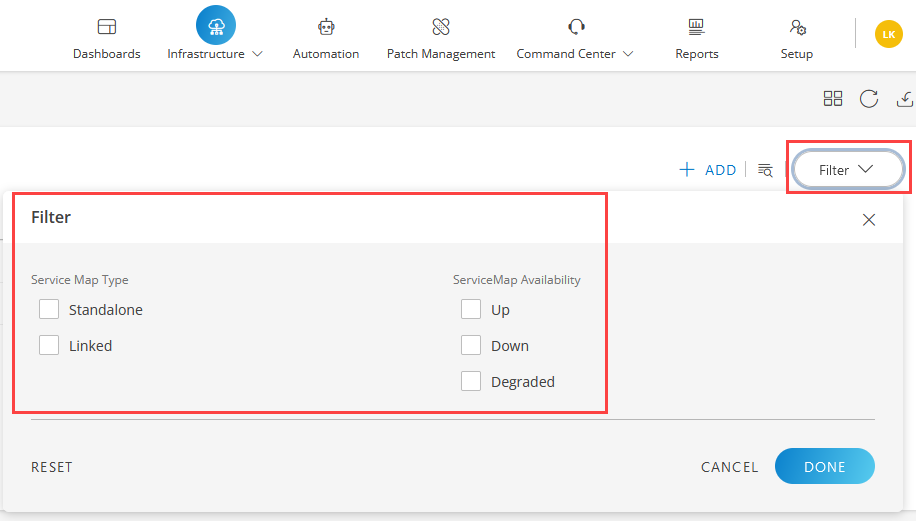
The Service Maps are further categorized based on the following criterion:
Service Map Type
Standalone: Service maps that are individual and are not linked with another service map.
Linked: Service maps that are linked to other service maps. A link icon appears next to a linked service map as highlighted in the illustration.

Service Map Availability
- Up: Service maps that are in Up status are filtered and displayed. A green colored bar is also displayed next to the map to indicate the same. If the resources in the node have healed alerts (OK) or no critical alerts on the availability metric, then it will be in the UP status.
- Down: Service maps that are in Down status are displayed. A red colored bar is also displayed next to the map to indicate the same. If the resources in the node have critical alerts on the availability metric, then it will be in down status.
- Degraded: Service maps that are in Degraded status are displayed. An orange colored bar is also displayed to indicate the same. If a service map has 2 nodes and the Availability Threshold number is greater than or equal to 2, if one of the nodes goes down, the service goes into the degraded status and sends a warning alert.
See Create Service Maps to learn about availability thresholds.
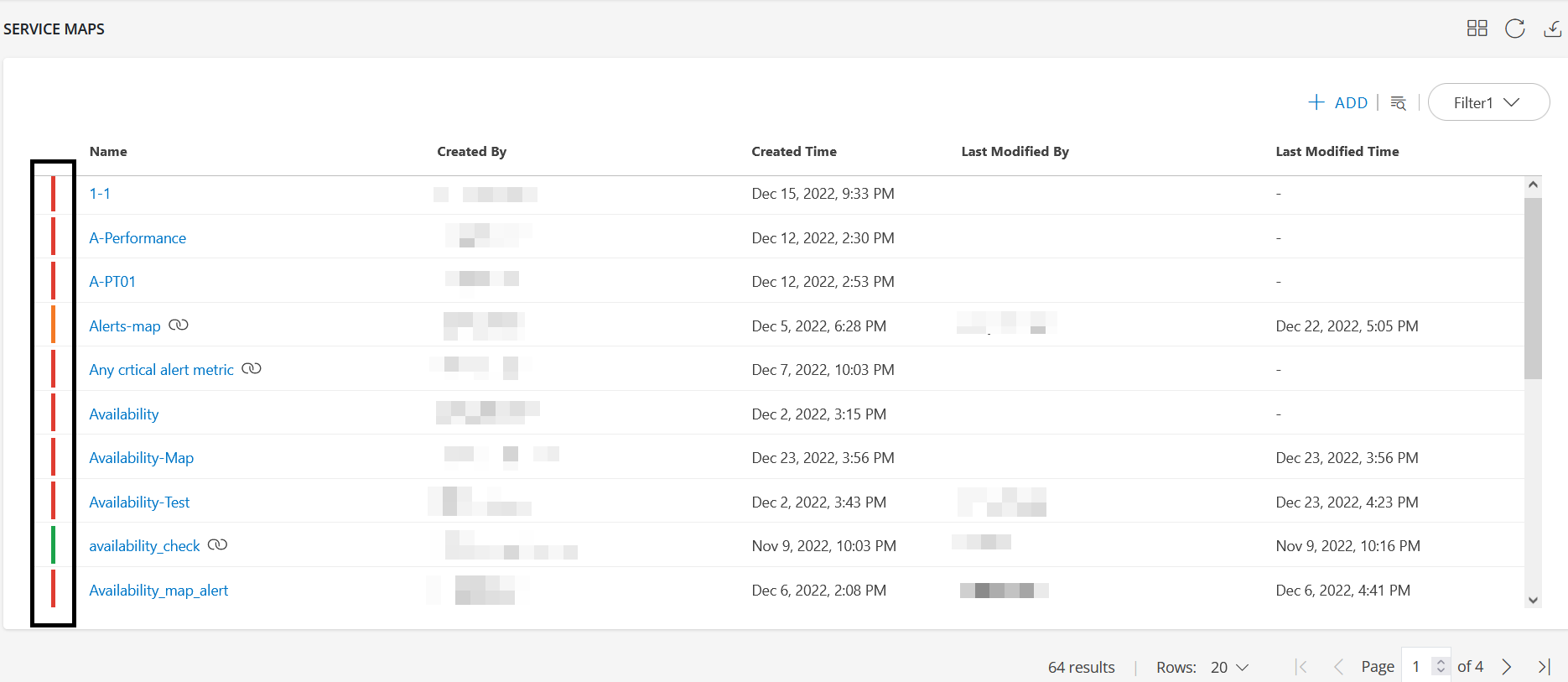
To filter, from the Service Maps page, click the Filters drop-down menu.
Manage Service Maps
You can do various actions on the Service Maps. For example, you can view the horizontal or vertical layout of the Service Maps.
| Property | Description |
|---|---|
| Refresh | Used to force refresh the Service Maps. The Refresh icon is located at the top right corner of the Service Maps. |
| Expand | Used to view all the nodes. This functionality is useful if the nodes are collapsed and hidden. The Expand icon is located at the top right corner of the Service Maps. |
| Edit | Used to edit any node in a Service Maps. The Edit icon is located at the top right corner of the Service Maps. |
| Toggle | Used to view the horizontal or vertical layout of a Service Maps. The Toggle icon is located at the top right corner of the Service Maps. |
| Full Screen | Used to view the Service Maps in full screen mode. The Full Screen icon is located at the top right corner of the Service Maps. |
Service Maps listing page
All the configured services appear on the Service Maps page. You can search, change the view, import, and export a service, remove a service, and also refresh a Service Maps list.
To view the Service Maps listing page:
From All Clients, select a client.
Go to Infrastructure > Services. The Service Maps page is displayed with the list of all services.
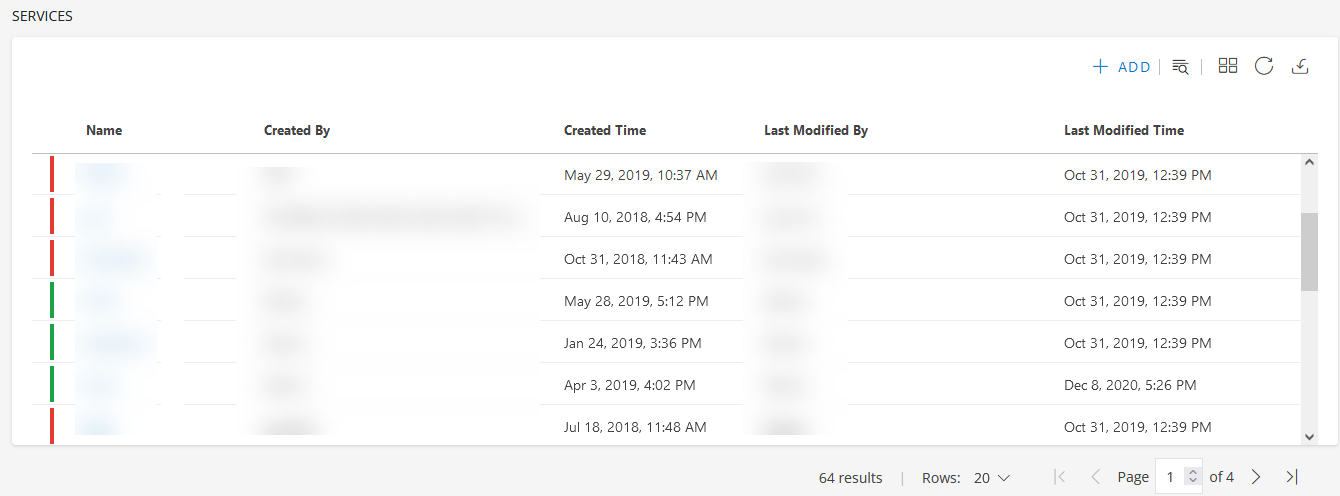
The Service Maps listing page has the following information:
| Attribute | Description |
|---|---|
| Name | Name of the Service Maps. |
| Created By | Name of the user who created the Service Maps. |
| Created Time | Time the Service Maps was created. |
| Last Modified By | Name of the user who last modified the Service Maps. |
| Last Modified Time | Time the Service Maps was last modified. |
Dependent Service Maps
Service maps that are dependent on other service maps have a link icon with the service map name, on the service maps listing page.

- Click the service map with a link icon. A link icon with the count of the dependent service maps is shown.
- Click the number. The service map names that are dependent on the service map are displayed.

You can click the dependent service map link to view the dependent service maps details page.
This will help you to identify the impact on the dependent service maps before you make any changes to the main service map.
Search for a service
To search for a service:
Go to Infrastructure > Service Maps. The Service Maps page is displayed with the list of all service maps.
Click the Search icon and enter the search string in the search box.
The search result is displayed.

View Alerts, Incidents, and Resources
You can view the summary of impacted alerts, incidents, and impacted resources in a slide-out screen from the Service Maps page.
To view:
Go to Infrastructure > Service Maps. The Service Maps page is displayed with the list of all service maps.
Choose the required Service Maps and click anywhere in the row.
- The slide-out screen with the details of Alerts, Incidents, and Resources is expanded.
- The name of the Service Maps appears as the heading in the slide-out.
- Click the > icon to collapse the slide-out screen.
The slide-out provides the following information for each category:
Alerts
You can perform the following actions:- View a list of Alerts and Alert Updated Time. Click an alert to view more information on the alert browser that is displayed.
- Search for an alert using the search_with_name field. Enter the full alert id.
Incidents
You can perform the following actions:- View a list of Incidents and Status. Click an incident to view more information on the service desk page.
- Search for an incident using the search box with the incident id. Enter the full incident id.
Resources
You can perform the following actions:- View a list of Resources. Click a resource to view more information on the Resource Overview page.
- Use the resource name to search for the resources. The list of names is displayed as you start typing.

Change view
To change a service view:
Go to Infrastructure > Service Maps. The Service Maps page is displayed with the list of all service maps.
Click on the grid view icon to change from the list view to the grid view. Likewise, click on the list view icon to change from the grid view to the list view.
Import and Export a service map
To import Service Maps:
Go to Infrastructure > Service Maps. The Service Maps page is displayed with the list of all service maps.
Click the import icon and then click Upload JSON File on the IMPORT SERVICE popup.
Note: Only one Service Maps can be imported at a time.
To export Service Map:
Go to Infrastructure > Service Maps. The Service Maps page is displayed with the list of all service maps.
Search for the Service Maps and hover mouse on a row.
Click the action menu at the end of the row and then click Export.
The Service Maps is exported as a JSON file.
Remove Service Maps
To remove Service Maps:
Go to Infrastructure > Service Maps. The Service Maps page is displayed with the list of all service maps.
Search for the Service Maps and hover mouse on a row.
Click the action menu at the end of the row and then click Remove.
Click REMOVE on the confirmation popup. The following message appears: Are you sure you want to remove the Service Maps?
Click REMOVE to delete and the Service Maps is removed. click CANCEL to go back.
Refresh the Service Maps
To refresh the Service Maps:
Go to Infrastructure > Service Maps. The Service Maps page is displayed with the list of all service maps.
Click the refresh icon. The list is refreshed.